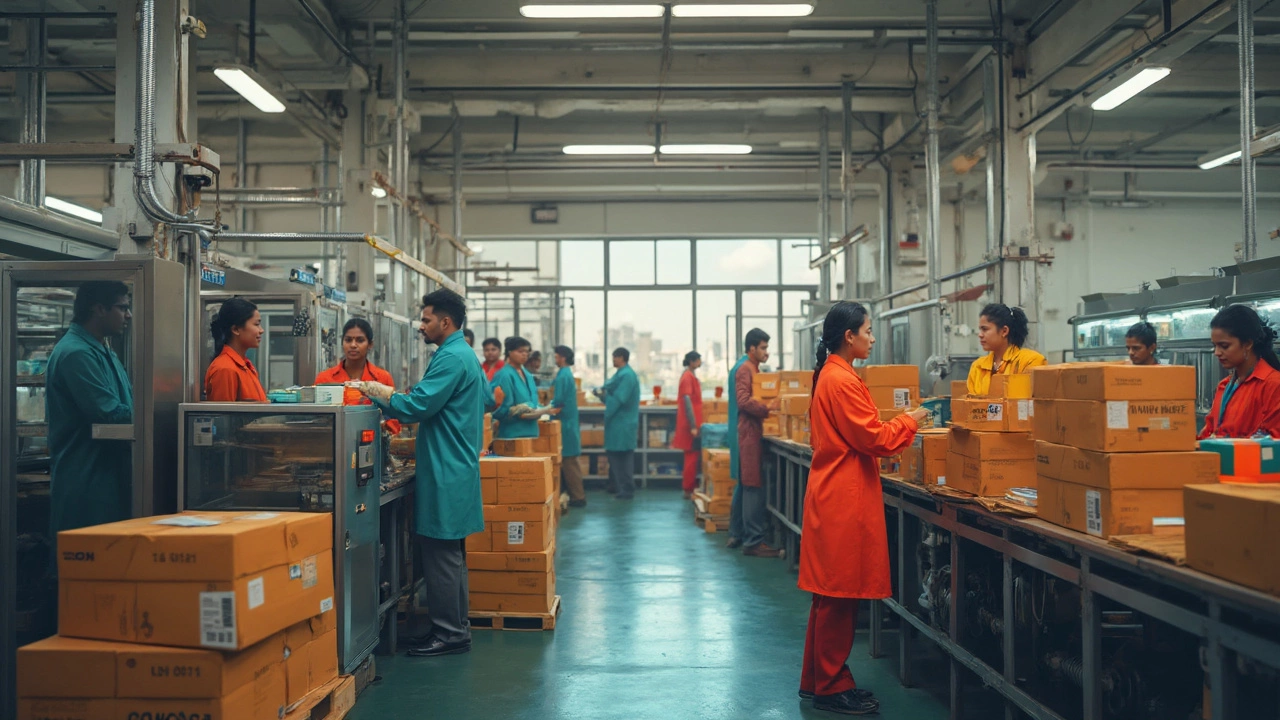
Here’s something wild: if you grab a box of common antibiotics in Africa or life-saving HIV medication in Brazil, there’s a good chance it originated in India. India isn’t just a regular player in the pharmaceutical business; it’s the MVP. Pharma manufacturers in India ship billions of pills worldwide, and most folks outside South Asia have no idea just how much their own healthcare depends on it.
This isn’t by accident. Indian pharma companies cracked the code on making quality medications at prices that even public hospitals in poorer countries can handle. The secret sauce? A mix of government policies, fierce competition, and a knack for making generic drugs that are just as good as their expensive branded cousins.
Trying to understand why India is the pharmacy of the world? You’ll want the full story, because it’s not just about low costs. There’s a huge focus on quality, worldwide compliance, and innovation too. Plus, if you’re hunting for tips on working with Indian pharma exporters, you’re in the right spot.
- The Rise of Indian Pharma
- Generics Power: Making Medicines Affordable
- Meeting Global Quality Standards
- Indian Pharma’s Global Impact and Tips for Buyers
The Rise of Indian Pharma
If you’re wondering how pharma manufacturers India jumped from being barely noticed to dominating medicine exports, it all boils down to smart choices and perfect timing. Back in the 1970s, India changed its patent laws. Instead of letting foreign companies hold exclusive drug patents, the government allowed local players to make generic versions. Suddenly, Indian companies could reverse-engineer high-demand drugs, fueling fierce competition and making prices drop like a rock.
This wasn’t the wild West; Indian know-how and strict processes kept quality high. Fast forward to today: over 50% of the world’s vaccines are made by Indian companies, and about 20% of global generic drugs come from India. It's hard to find an affordable pharmacy anywhere on the planet that doesn’t stock something from this country.
| Year | India's Pharma Exports (USD Billion) |
|---|---|
| 2000 | 1.5 |
| 2010 | 10.3 |
| 2024 | 25.4 |
None of this happened by mistake. The Indian government invested in pharmacy colleges and research. Cities like Hyderabad and Ahmedabad became pharma hotspots. Family-run firms, like Cipla and Sun Pharma, plowed money into state-of-the-art factories that passed tough inspections by the US FDA and European agencies. Today, more than 600 Indian pharmaceutical industry plants are approved by the US FDA—the most outside the US itself.
Key moves that helped India rise fast in pharma:
- Adopting flexible patent laws in the 1970s
- Massive investments in science and pharmacy education
- Building factories that met strict global standards
- Backing local generic production so medicines hit markets cheaper and faster
Now, Indian companies supply everything from basic paracetamol to advanced cancer drugs—at a fraction of the price compared to Western brands. No wonder global buyers, from African governments to US hospitals, work closely with pharma manufacturers India every day.
Generics Power: Making Medicines Affordable
If there’s one thing that really sets pharma manufacturers India apart, it’s their crazy grip on the global generics market. Generics are basically the same as the original brand-name drugs, except way cheaper. Indian companies got really good at making these right after the country tweaked its patent laws in 1970. Once those rules hit, local firms could make copies of medicines no longer under patent abroad, and that completely changed the game.
Today, around 1 in 5 generic medicines worldwide comes out of India. The country isn’t just pumping out a few pills—it’s producing everything from blood thinners to cancer treatments. Some of the heavy hitters like Sun Pharma, Cipla, and Dr. Reddy’s churn out billions of doses each year, and their products end up in the U.S., Europe, Africa, and practically everywhere else.
Here’s how generics have made affordable healthcare possible:
- Prices can be up to 90% lower than brand-name drugs.
- India exports medicines to over 200 countries, including high-income and developing countries alike.
- Pharma manufacturers in India supply about 40% of generic medicines to the United States alone.
- During the AIDS crisis, affordable Indian generics slashed the cost of HIV treatment from $10,000/year to less than $100/year, saving millions of lives.
Want to see how much of a difference this makes in dollars and cents? Check out these numbers on generic export volumes and destinations:
| Region | Volume Share (%) | Main Medications |
|---|---|---|
| United States | 40 | Generic pills, injectables |
| Africa | 20 | HIV/AIDS, malaria drugs |
| Europe | 15 | Chronic disease drugs |
Generic medicines from India aren’t just about slashing costs—they meet the same quality standards set by the FDA or EMA. That’s why so many governments and non-profits trust Indian drug makers to stock their hospitals. For people facing tough medical bills, this can mean fewer tradeoffs between health and rent.

Meeting Global Quality Standards
Most people assume cheap medicines mean poor quality, but that’s not the story with pharma manufacturers India hosts. India’s biggest pharmaceutical exporters jump through serious hoops to meet the strict rules of the US FDA, the UK MHRA, and the World Health Organization. Over 600 Indian pharma plants are approved by the US FDA, which is way more than any other country outside the US. That’s a bold stamp showing Indian meds make the cut for America’s super-tough healthcare system.
Quality isn’t just about passing a test once—it’s about rolling out millions of pills, vials, and tablets every week that are all up to spec. Indian manufacturers lean into:
- Regular audits from foreign and Indian agencies
- Strict batch testing and process controls
- Clean, high-tech production plants that rival those in Europe or the States
Want a clear example? Cipla, an Indian giant, was the first in the world to launch a generic triple HIV therapy for less than $1 a day—only after hitting all global safety bars. No corners cut, just solid, affordable science.
| Region | No. of Approved Facilities | Agencies Involved |
|---|---|---|
| United States | 600+ | US FDA |
| Europe | 250+ | EMA, UK MHRA |
| Japan | 80+ | PMDA |
This massive regulatory footprint means Indian-made generics and medicines can be found in more than 200 countries. And they’re not just backup options—sometimes, they’re the backbone of the health system, especially where budgets are tight and the need for reliable, cheap medicine is always on. The secret? Relentless focus on world standards, every step of the way.
Indian Pharma’s Global Impact and Tips for Buyers
Indian pharma manufacturers aren’t just filling local pharmacies—they’re making their mark across more than 200 countries. Around 20% of generic medicines supplied worldwide come from India. The country makes about 60% of all vaccines sold globally. You’ll spot Indian-made medicines everywhere, from American clinics to African rural hospitals.
The reach is huge because of affordability, but also because of strict quality checks. Indian companies like Sun Pharma, Cipla, and Dr. Reddy’s meet tough standards set by the US FDA, WHO, and the European Medicines Agency. That means buyers don’t have to compromise on safety just to save money.
| Stat | Value |
|---|---|
| India’s share in global generic drug exports | ~20% |
| Share of global vaccine supply from India | ~60% |
| Countries importing Indian medicines | 200+ |
If you’re looking to source medicines from pharma manufacturers India, there are some smart moves to keep in mind:
- Check certifications: Look for companies approved by agencies like the US FDA or WHO-GMP. These marks show the products meet global quality rules.
- Compare pricing, but don’t only go cheap. While Indian drugs are known for great value, always check exactly what the quoted price covers—packaging, shipping, and paperwork add up.
- Ask about logistics support. Trusted suppliers help you navigate customs, export paperwork, and shipping so your order isn’t stuck at a border.
- Request samples or references. Reputable exporters are happy to show off product samples or connect you to other buyers as references.
The bottom line: India’s pharmaceutical industry isn’t just big—it's reliable. From affordable generics to global quality standards, working with Indian pharmaceutical industry can be a win-win if you do your homework and partner with experienced exporters.